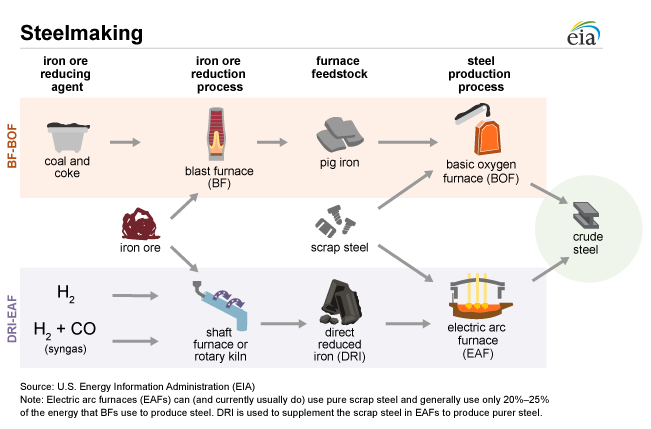Decarbonizing Steel + Industrial Acquisitions
Inside this issue
This month the EIA released potential impacts of low-carbon steel efforts internationally. Producing steel is a energy-intensive process and today relies on coal, natural gas, and hydrogen. Throughout the production process, there are key opportunities to reduce emissions, increase hydrogen, optimize electricity consumption, and efficiently use iron ore and scrap steel.

Based on the EIA analysis, about 2/3 of the world’s steel is produced by a coal-based and carbon-intensive process where iron ore is heated and reduced by a coke (made by heating coal) to produce iron in a blast furnace (BF).
Direct Reduced Iron (DRI) is the product of the direct reduction of iron ore in the solid state by carbon monoxide and hydrogen derived from natural gas or coal.
Costs vary across geographies; however, OECD Europe is well-positioned to adopt "Green Steel" or low-carbon steel production
OECD Europe, the region in this analysis with the largest decline in the carbon intensity of crude steel production, has sufficient land resources for wind and solar projects, a high level of scrap steel availability, and existing natural gas pipelines that can be converted to move hydrogen to industrial users, facilitating its potential transition to a low-carbon steelmaking industry.
Source: EIA
⚡️ Action - Engage Steel Producers
Start the conversation to collaborate, find, and solve for potential opportunities:
- Carbon capture at the facility
- Use alternative fuels at the facility
- Replace fossil fuels with hydrogen
- Increase renewable electricity consumption
Inside this Issue
💰 Haynesville acquisition to increase RSG and LNG takeaway
🚚 TerraVest Industries acquires Mississippi Tank
🔋 Retriev Technologies Acquires Battery Solutions
🔌 Schneider Electric acquires Aurtra to advance service innovation
☀️ Macquarie Acquires France based Reden Solar for $2.7 Billion
🤖 Baker Hughes acquires Qi2 Elements
Articles in this issue